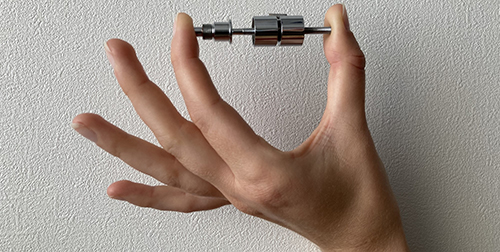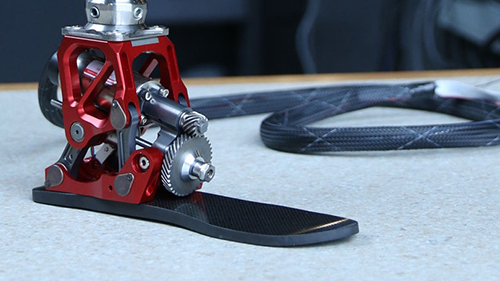|
Listen to this article  |

By Michael Boudreau, P.Eng., Application Engineering Manager, Rollvis SA

You may not be familiar with roller screws, but these compact, high-efficiency screw drives are an important technology in the production of everyday devices and products. In fact, there were probably more than 20 roller screws involved in the manufacture and assembly of your vehicle – performing functions such as punching, tube bending, and riveting.
But roller screws aren’t just for automotive applications and heavy industries such as injection molding and machining. On the contrary – roller screws can produce the smallest displacements (movements) of any screw technology while maintaining extremely quiet and smooth operation, making them ideal for applications in a wide variety of robotic fields.
What robots need: High efficiency, compact size
When it comes to precision screw technologies, there are three basic choices: lead screws, ball screws, and roller screws. Lead screws are versatile in their design and material options, but they suffer from relatively poor efficiency and load capacity. Ball screws have good efficiency, but when the application calls for a small screw diameter and low lead, load capacity suffers because the load-carrying balls must also be very small. Roller screws, on the other hand, have good thrust force capabilities in a compact overall size, along with excellent efficiency – the best of all worlds. Case in point: When comparing the load capacity and efficiency values for different screw technologies of similar diameters, all with a 1 mm lead, a roller screw has four times the load capacity of a ball screw with efficiency that’s twice as high as that of a lead screw.

A roller screw with a 1 mm lead has four times the load capacity of a similarly sized ball screw and twice the efficiency of a similarly sized lead screw.
This combination of performance and design characteristics makes roller screws an ideal solution for many robotic and robot-related applications. For example, robots that use linear activation for joint linkages (similar to the way your bicep muscle controls the movement of your forearm) benefit from the higher load rating and lower weight of roller screw actuators.
In robot gripper applications, roller screws can provide the extremely high levels of holding force that are required for secure clamping – and can do so with a minimal torque input. The key to this combination of high force and low input torque is to use a screw with a very small lead, such as the Rollvis RVR type recirculating roller screw, which can be manufactured with leads down to 0.5 mm or even 0.25 mm
Roller screws can also be used in robotic end of arm tooling. In these applications, the roller screw’s ability to produce high thrust in a small package provides an advantage over other solutions. This is because keeping weight (mass) low is critically important for components that sit at the end of a robot arm. Heavy loads located at the end of the robot arm create significant inertia, making precise control of the robot’s movement more difficult and, in some cases, requiring larger motors and other drivetrain components. This excellent power-to-weight ratio is a key reason why robotic spot welders and auto riveters overwhelmingly use roller screws for actuation.
Trends in robotics and mobile applications
Modern computing, manufacturing methods and battery technology have led to rapid advancements in automation and electrification, creating a host of new robotics and mobile applications that weren’t possible just a few years ago. One example is the development of active prostheses (prosthetics that are powered by motors), which greatly improve function and use for amputees.
Unlike large industrial robots, in which each joint uses its own motor and gearbox, many active prosthetics use screw-driven linear actuation, which allows for a smaller, lighter, and stronger design. While various types of screws can be used in active prostheses, roller screws offer an important benefit over other technologies – an unmatched performance-to-size ratio. For example, a roller screw with a diameter of just 3.5 mm – small enough to fit in the palm of your hand – can push loads up to 500 lb and execute movements in the micron and sub-micron range, to better mimic human joints and fingers.

The adoption of powered prostheses and powered exoskeletons depends in large part on developments that make these devices smaller, lighter-weight, and more user-friendly. Roller screws contribute to all three of these aims by providing actuation capabilities in the micron and sub-micron range, for movements that better replicate human joints and fingers. Image courtesy of T. Lenzi, University of Utah
Powered exoskeletons are another rapidly-growing robotic technology. In fact, the exoskeleton market is projected to grow by more than 46 percent from 2021 to 2026, with powered exoskeletons making up the larger share of this growth (as compared to passive exoskeletons)1.
Although we would love to be able to program robots to take on any manual task that is too heavy or risky for humans, there are just too many variables for this to be practical for many applications, such as trimming branches from trees in residential yards. The solution is a human-driven (exoskeleton) or actively controlled robot. This solution combines human decision making with lower risk, fewer injuries, and increased lifting capacity. And like prostheses, exoskeletons face design constraints related to weight, size, and complexity. Here, too, the extremely high force-to-size and force-to-weight ratio, make roller screws an ideal solution.
And the smaller and more mobile a robotic application becomes, the more that attributes such as power consumption, size, and weight become constraining factors. Whether it be drones, autonomous underwater vehicles (AUVs), or space-based rovers, the demands are similar: high efficiency, strength, and reliability in the smallest possible footprint. Whatever the size, form factor, or application, Rollvis offers a roller screw design that can provide the ideal combination of thrust force, size, weight, and efficiency to improve performance and reliability.
- Markets and Markets, “Exoskeleton Market by Component (Hardware and Software), Type (Powered and Passive), Mobility (Stationary and Mobile), Body Part (Lower, Upper, and Full Body), Vertical (Healthcare, Defense, and Industrial), and Geography – Global Forecast to 2023
Sponsored content by Rollvis
Credit: Source link


Comments are closed.